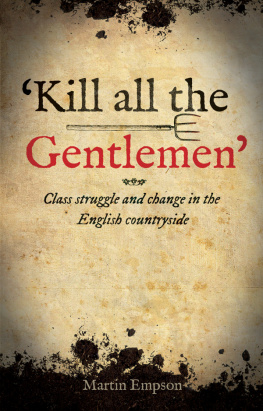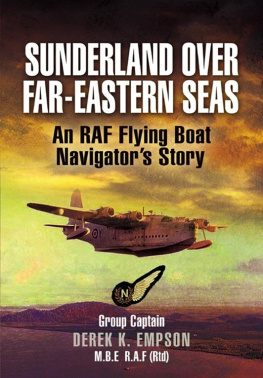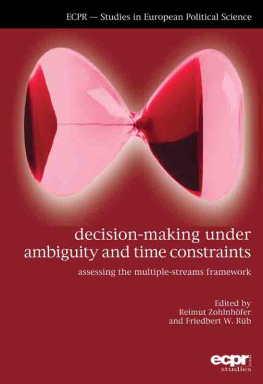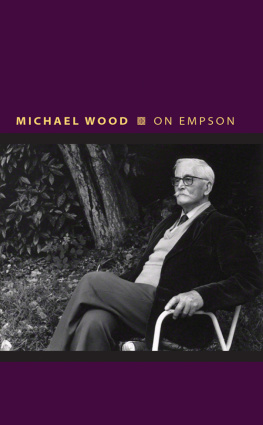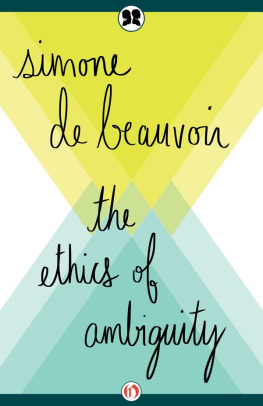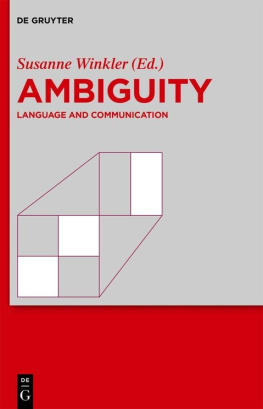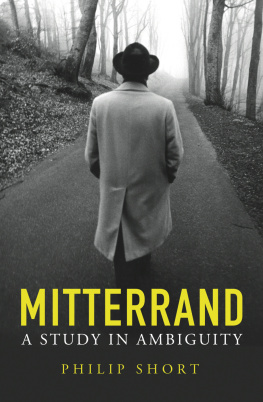Empson - Seven Types Of Ambiguity
Here you can read online Empson - Seven Types Of Ambiguity full text of the book (entire story) in english for free. Download pdf and epub, get meaning, cover and reviews about this ebook. City: United States, year: 2016, publisher: Read Books Ltd, genre: Religion. Description of the work, (preface) as well as reviews are available. Best literature library LitArk.com created for fans of good reading and offers a wide selection of genres:
Romance novel
Science fiction
Adventure
Detective
Science
History
Home and family
Prose
Art
Politics
Computer
Non-fiction
Religion
Business
Children
Humor
Choose a favorite category and find really read worthwhile books. Enjoy immersion in the world of imagination, feel the emotions of the characters or learn something new for yourself, make an fascinating discovery.

Seven Types Of Ambiguity: summary, description and annotation
We offer to read an annotation, description, summary or preface (depends on what the author of the book "Seven Types Of Ambiguity" wrote himself). If you haven't found the necessary information about the book — write in the comments, we will try to find it.
Empson: author's other books
Who wrote Seven Types Of Ambiguity? Find out the surname, the name of the author of the book and a list of all author's works by series.
Seven Types Of Ambiguity — read online for free the complete book (whole text) full work
Below is the text of the book, divided by pages. System saving the place of the last page read, allows you to conveniently read the book "Seven Types Of Ambiguity" online for free, without having to search again every time where you left off. Put a bookmark, and you can go to the page where you finished reading at any time.
Font size:
Interval:
Bookmark:

The sorts of meaning to be considered; the problems of Pure Sound and of Atmosphere. First-type ambiguities arise when a detail is effective in several ways at once, e.g. by comparisons with several points of likeness, antitheses with several points of difference ().
In second-type ambiguities two or more alternative meanings are fully resolved into one. Double grammar in Shakespeare Sonnets. Ambiguities in Chaucer () on emendations of Shakespeare and on his form The A and B of C.
The condition for third-type ambiguity is that two apparently unconnected meanings are given simultaneously. Puns from Milton, Marvell, Johnson, Pope, Hood. Generalised form () when there is reference to more than one universe of discourse; allegory, mutual comparison, and pastoral. Examples from Shakespeare, Nash, Pope, Herbert, Gray. Discussion of the criterion for this type.
In the fourth type the alternative meanings combine to make clear a complicated state of mind in the author. Complete poems by Shakespeare and Donne considered. Examples () of alternative possible emphases in Donne and Hopkins. Pope on dowagers praised. Tintern Abbey accused of failing to achieve this type.
The fifth type is a fortunate confusion, as when the author is discovering his idea in the act of writing (examples from Shelley) or not holding it all in mind at once () that later metaphysical poets were approaching nineteenth-century technique by this route; examples from Marvell and Vaughan.
In the sixth type what is said is contradictory or irrelevant and the reader is forced to invent interpretations. Examples from Shakespeare, Fitzgerald, Tennyson, Herbert (), Pope, Yeats. Discussion of the criterion for this type and its bearing on nineteenth-century technique.
The seventh type is that of full contradiction, marking a division in the authors mind. Freud invoked. Examples () of minor confusions in negation and opposition. Seventh-type ambiguities from Shakespeare, Keats, Crashaw, Hopkins, and Herbert.
General discussion of the conditions under which ambiguity is valuable and the means of apprehending it. Argument that theoretical understanding of it is needed now more than previously. Not all ambiguities are relevant to criticism; example from Jonson (). Discussion of how verbal analysis should be carried out and what it can hope to achieve.
THE first and only previous edition of this book was published sixteen years ago. Till it went out of print, at about the beginning of the war, it had a steady sale though a small one; and in preparing a second edition the wishes of the buyers ought to be considered. Many of them will be ordering a group of books on this kind of topic, for a library, compiled from bibliographies; some of them maybe only put the book on their list as an awful warning against taking verbal analysis too far. Anyway, such a buyer wants the old book, not a new one, even if I could make it better. On the other hand, there was obviously room to tidy up the old one, and I would not want to reprint silently anything I now think false.
It seemed the best plan to work the old footnotes into the text, and make clear that all the footnotes in this edition are second thoughts written recently. Sometimes the footnotes disagree with the text above them; this may seem a fussy process, but I did not want to cut too much. Sir Max Beerbohm has a fine reflection on revising one of his early works; he said he tried to remember how angry he would have been when he wrote it if an elderly pedant had made corrections, and how certain he would have felt that the man was wrong. However, I have cut out a few bits of analysis (hardly ever without a footnote to say so) because they seemed trivial and likely to distract the readers attention from the main point of the passage; I have tried to make some of the analyses clearer, and occasionally written in connecting links; the sources of the quotations needed putting in; there were a lot of small proof corrections to make; and some of the jokes which now seem to me tedious have gone. I do not think I have suppressed quietly any bit of analysis which would be worth disagreeing over. There is now an index and a summary of chapters.
I was surprised there was so little of the book I should prefer to change. My attitude in writing it was that an honest man erected the ignoring of tact into a point of honour. Apart from trailing my coat about minor controversies, I claimed at the start that I would use the term ambiguity to mean anything I liked, and repeatedly told the reader that the distinctions between the Seven Types which he was asked to study would not be worth the attention of a profounder thinker. As for the truth of the theory which was to be stated in an irritating manner, I remember saying to Professor I. A. Richards in a supervision (he was then my teacher and gave me crucial help and encouragement) that all the possible mistakes along this line ought to be heaped up and published, so that one could sit back and wait to see which were the real mistakes later on. Sixteen years later I find myself prepared to stand by nearly the whole heap. I have tried to clear the text of the gratuitous puzzles of definition and draw attention to the real ones.
The method of verbal analysis is of course the main point of the book, but there were two cross-currents in my mind leading me away from it. At that time Mr. T. S. Eliots criticism in particular, and the Zeitgeist in general, were calling for a reconsideration of the claims of the nineteenth-century poets so as to get them into perspective with the newly discovered merits of Donne, Marvell, and Dryden. It seemed that one could only enjoy both groups by approaching them with different and incompatible presuppositions, and that this was one of the great problems which a critic ought to tackle. My feeling now is not so much that what I wrote about the nineteenth century was wrong as that I was wrong in tackling it with so much effort and preparation. There is no need to be so puzzled about Shelley. But I believe that this looking for a puzzle made me discover something about Swinburne, and I did not treat the Keats Ode to Melancholy as a dated object.
The second cross-current was the impact of Freud. Some literary critics at the time were prepared to collaborate with the invading psycho-analysts, whereas the honest majority who were prepared to fight in the streets either learned fire-watching technique or drilled with the Home Guard. This problem, too, I think, has largely settled itself in the intervening years, and I can claim that my last example of the last type of ambiguity was not concerned with neurotic disunion but with a fully public theological poem. However, I want now to express my regret that the topical interest of Freud distracted me from giving adequate representation in the seventh chapter to the poetry of straightforward mental conflict, perhaps not the best kind of poetry, but one in which our own age has been very rich. I had not read Hart Crane when I published the book, and I had had the chance to. Mr. T. S. Eliot, some while ago (speaking as a publisher), remarked that poetry is a mugs game, and this is an important fact about modern poets. When Tennyson retired to his study after breakfast to get on with the
Font size:
Interval:
Bookmark:
Similar books «Seven Types Of Ambiguity»
Look at similar books to Seven Types Of Ambiguity. We have selected literature similar in name and meaning in the hope of providing readers with more options to find new, interesting, not yet read works.
Discussion, reviews of the book Seven Types Of Ambiguity and just readers' own opinions. Leave your comments, write what you think about the work, its meaning or the main characters. Specify what exactly you liked and what you didn't like, and why you think so.

